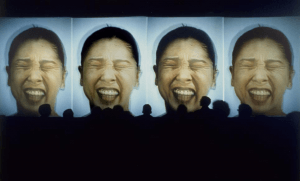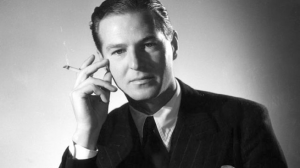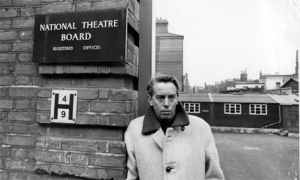My notes on Digital Aesthetics and Embodied Perception: Towards a Postmodern Performance by Rosemary Klich and Edward Scheer.
Multimedia performance of: “Modell 5’s Granular Synthesis”
“…new media is defined by the principles of Numerical Representation, Modularity, Automation, Variability, and Transcoding.” (Klich and Scheer, 2011, 179).
“Through its meddling with the structure of the representational image, the ability of the digital medium to augment then simulation of reality, and so create new possibilities for performance, becomes apparent.” (Klich and Scheer, 2011, 184-185).
“The digital domain allows Granular Synthesis to denature and deconstruct image and sound components, and bring them into a space of abstraction where they can undergo shared algorithmic procedures. These algorithmic procedures are also conceptual formulations that Granular Synthesis apply to fusions of image and sound elements in order to alchemically renature and thus convert them back into lucid and persuasive fields of meaningful representation.
(Shaw, Cited in Klich and Scheer, 2011, 185).
“This work highlights the impact of digitalisation of representational imagery and explores the ramifications of this in relation to the rere-sentation of human bodies.
The medium in this work is not attempting to hide itself, to become immediate, but is foregrounded in the audio-visual field and re-emphasised in the reception of the image across the four channels. As such, the work is primarily ‘hypermediated’ in that the digital mediation of the sound and image is overt, and key visual element is the acting of the digital medium upon the representational image. This process is called ‘granular synthesis’, the name to a technique derived from the principles of digital sound design in which samples are split into tiny pieces of less than 50 milliseconds’ duration. These are called grains, which the different packets of grains are played at different speeds, creating phases” (granularsynthesis, Cited in, Klich and Scheer, 2011, 185).
“Physical reactions are unavoidable, and make their performances and installations a ‘dreadful’ experience wholly in keeping with Burke’s notion of ‘negative delight’. This disconnection from everyday is like being taken hostage in a vibrating color-space(ship) [Sic.]” (Richard, Cited in, Klich and Scheer, 2011, 86).
“The work invades our senses, assaulting and penetrating them. The pul-verisingly phat base-driven techno soundtrack feels as if it is doing permanent damage to our hearing even through the ear plugs provided while the component to Takaya is shown in extreme close up. These effects are hypnotic, and the atmosphere changes from an initially oppressive feeling to the experience of immersion. Jeffrey Shaw suggests: ‘The often seemingly aggressive audiovisual installation shake the viewer out of the stupor of habitual consumption and, in the best traditions of the avant-garde, bring about an unusual, even shocking, level of experimental intensity’ (Shaw, 2004). Yet the odour of sweaty bodies squashed into a small, hot room and the pounding base rhythms punctuated by Takeya’s synthesised screams affirms the liveness of the event even as it accompanies the inhuman four-channel projection” (Kilch and Scheer, 2011, 186).
“At an immediate level, the work functions to produce the ‘hyperreal’. The hyperreal is created when the mediated, virtual, or simulated are perceived as the real: ‘simulation of the real produces the hyperreal’ (Stevenson, 2002,p. 166). The images presented in Modell 5 are recognisably human features, though they are based on digital information which produces this hyperreal effect. Takeya’s face gradually transforms and mutates, and an image of an exotically beautiful woman becomes an entirely alien thing. The confusion of reality and virtuality creates a haze of hyperreality in which the ‘mediatedness’ of the images is accentuated[Sic.] ” (Klich and Scheer, 2011, 186).
A still capturing the intense atmosphere of Granular synthesis mid-performance.
Ideas relating to the subject of “Postman”.
“…envisions the emergent relationship between the human and the machine as creating a hybrid subjectively that is continuously moving between the material realm of bodily agency and the informational realm of digitality. As Brian Lennon elucidates, ‘cyborg or posthuman neither dystopically rejects the automaton, nor transcendentally dissolves itself in it, but instead moves continually between nature and culture, organic and synthetic, individual and collective’ (Lennon, 2000, p.66). [Sic.].”
(Lennon, Cited in, Klich and Scheer, 2011, 189).
“This kind of tormulation represents the context for the performer in multimedia performance, the constant moving between registers of perception and between material and informational modes of being in the world, between image and flesh.” (Klich and Scheer, 2011, 189).
“Hayle’s influential book, How We Became Posthuman: Virtual Bodies in Cybernetics, Literature, and Informatics (1999), explores the complexity of the human-machine interface and argues for an ‘embodied virtuality’. Hayles looks into the history of cybernetics to demystify the emergence of inhabited virtuality as the new condition for social existence of
and outlines the nature of this cultural shift. Hayles’s ‘posthuman point of view’ is characterised by four key assumptions that precondition its formation. First, informational pattern is privileged over material presence, so that biological embodiment is not viewed as a fixed and immutable origin or destiny of life but rather as an ‘accident of history’, as contingent and subject to creative mutation (Hayles, 1992, p. 2). Secondly, consciousness, widely understood as the locus of human identity, is viewed as an ‘evolutional upstart trying to claim that it is the whole show when in actuality it is only a minor sideshow’ (Hayles, 1999,p. 3). Thirdly, the body is viewed as a manipulable prosthesis, so that extending or altering the body with other prosthesis is essentially just the continuation of an ongoing process that begins before birth. Fourthly, the posthuman view constructs the human being so that it can be ‘seamlessly articulated’ with intelligent technology.”
(Klich and Scheer, 2011, 189).
“The posthuman subject rejects the ‘natural’ self, having become a composite, ‘an amalgam, a collection of heterogeneous components, a material-informational entity whose boundaries undergo continuous construction and reconstruction’ (Hayles, 1999,p. 3). As a fantastical as this may sound, this kind of posthuman subject negotiates and is interpolated within informational space as an ongoing feature of its social existence. When we check out balance online and navigate the portals of the online business environment, we live this hybrid experience. We are, for the purposes of the transaction and the entire online world, a username and a password combination. At our terminals we are grounded in a different and sensational world but this world in its social manifestations is cybernetic space in which our virtual and real experiences combine in a continuously constructed hybrid subjectivity” (Klich and Scheer, 2011, 190).
“…’the internet is not so much a case of a lack of physicality at all, but an alternative kind of operational system which connects physical bodies and machines with physical bodies in other places’
***
‘cybernetic corporeality is an extended and extruded embodiment that connects a multiplicity of remote bodies, spatially separated, but electronically connected.’
***
‘technology does not only replace what is missing from the body, but rather it constructs unexpected operational architectures. The body is not about lack, but rather about excess. It always has been. (Even the biological body alone performs with redundancy.) we are all prosthetic bodies with additional circurity that allows us to perform beyond the boundaries of our skins and beyond the local space we inhabit. Operating in the electronic space and electronics architectures, the body has spatially extended, telematically scaled loops of interaction’” (Scheer Cited in, Klich and Scheer, 2011, 198).
“In the virtual world we may consider the physical self as being absent, and in the real world we recognise the physical self as being present; however, when in the virtual self is no longer limited to the virtual world but becomes a functioning double, spatially located in material reality, the participant simultaneously exists in the real world as both a physical body and an informational pattern” (Klich and Scheer, 2011, 201).
Works Cited.
Klich. E and Scheer, R. (2011) Multimedia performance. New York: Palgrave Macmillan.
duduchier (2011) Modell 5 – Granular Synthesis. 3 September. Available from: https://www.youtube.com/watch?v=ATWljMbvVTg [accessed 17 November 2016].


